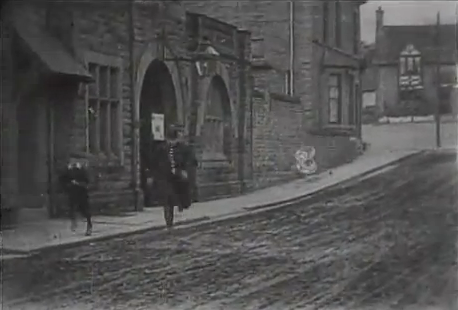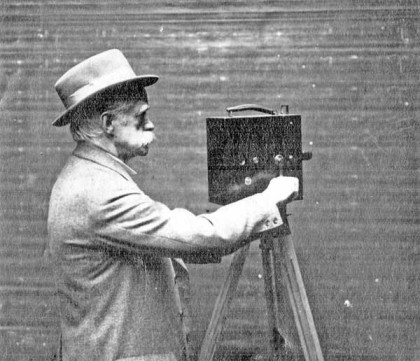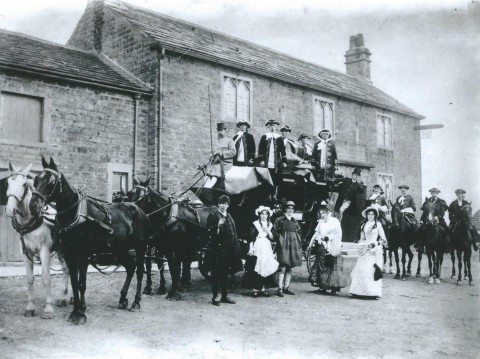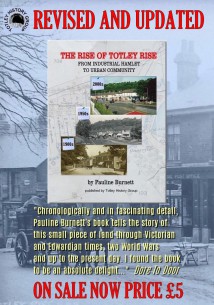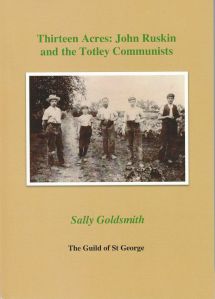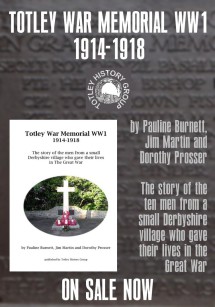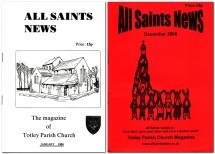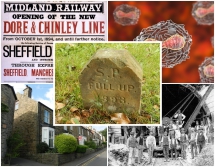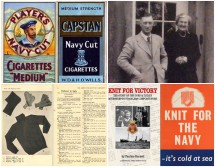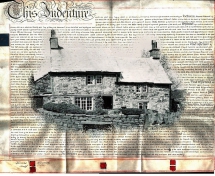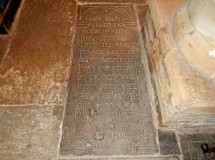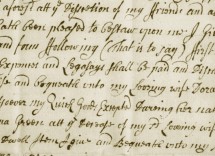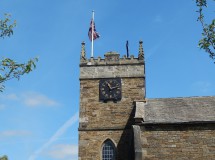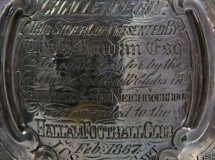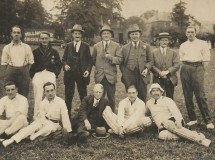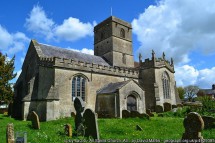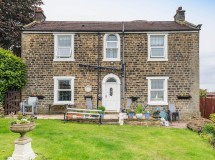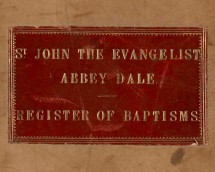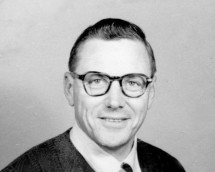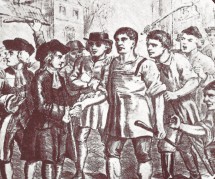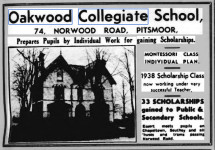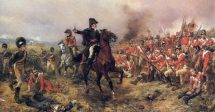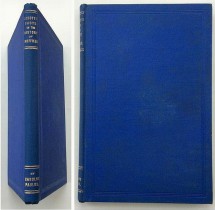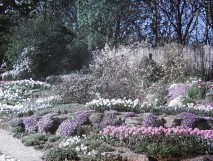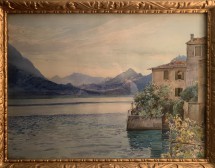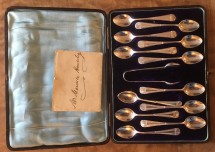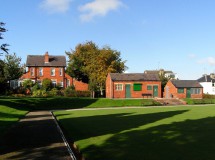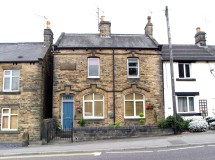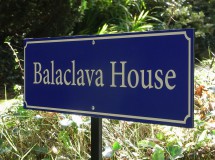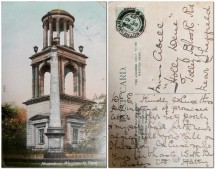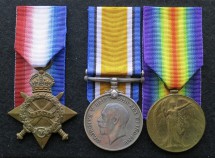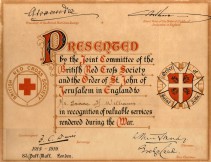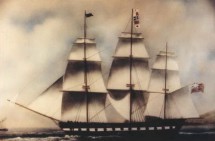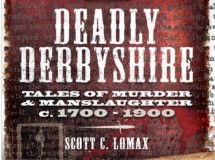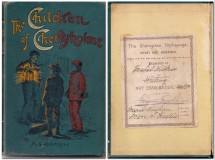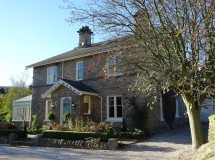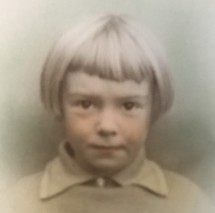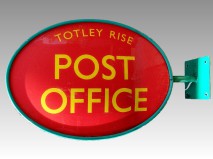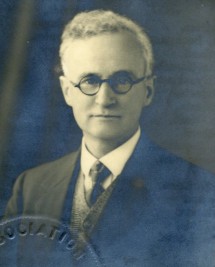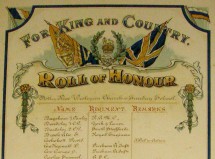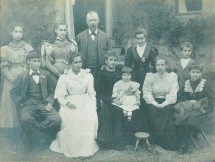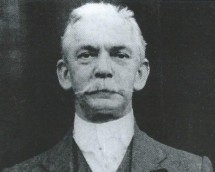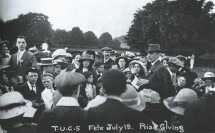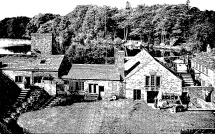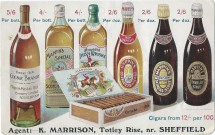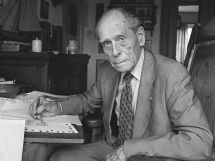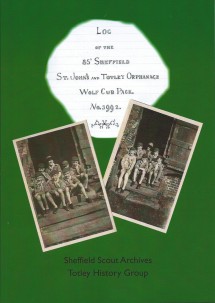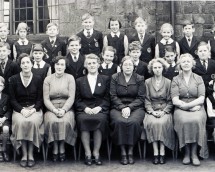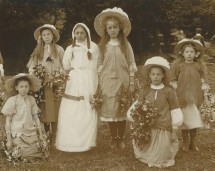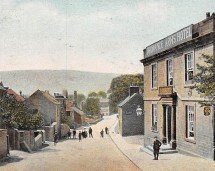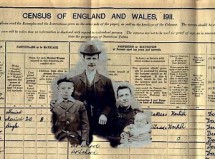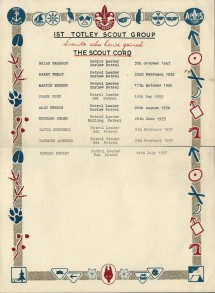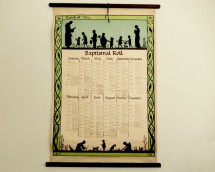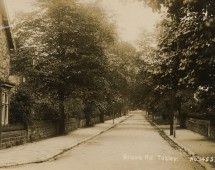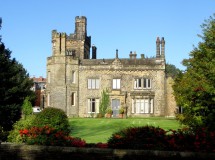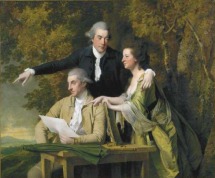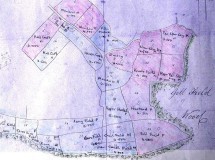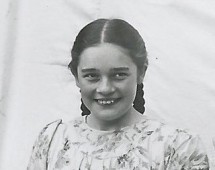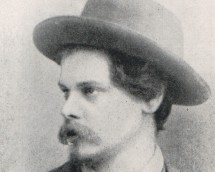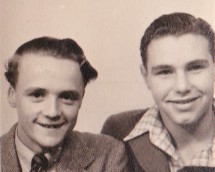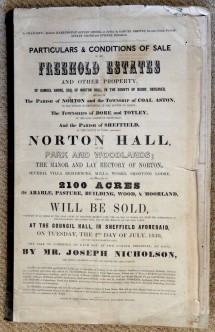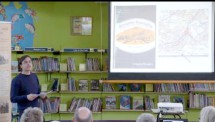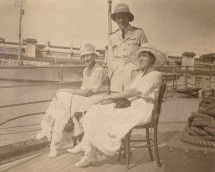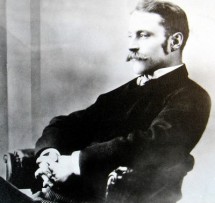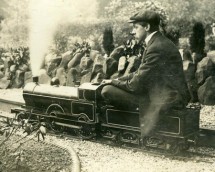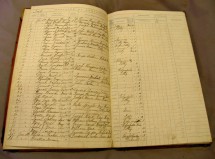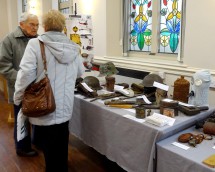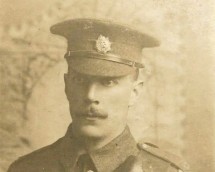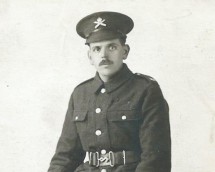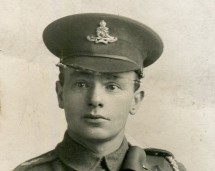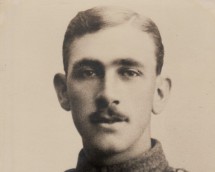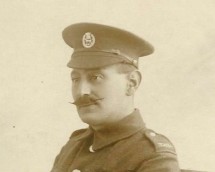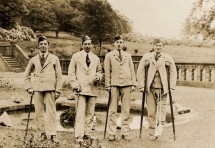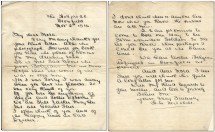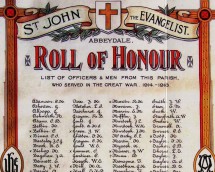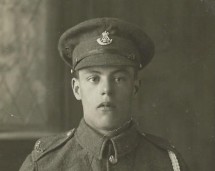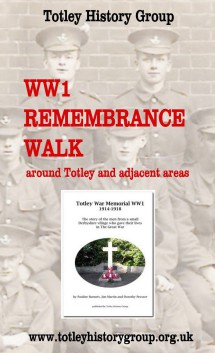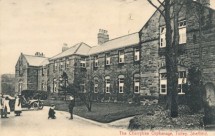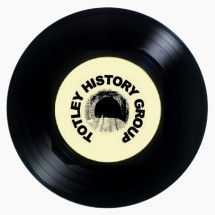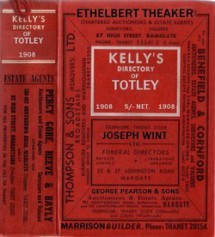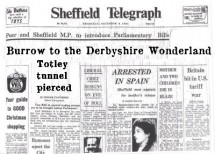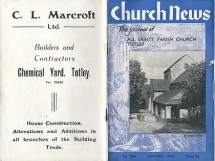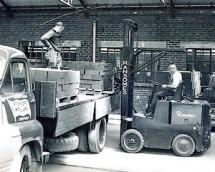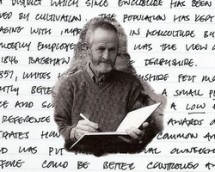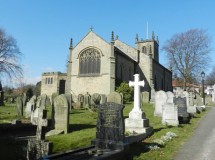Frank Mottershaw and the Sheffield Photo Co. Ltd.
The name of Frank Mottershaw has been linked with Totley and we would like to find out more about him. He was a photographer and film maker who started the Sheffield Photo Company and is credited with making the first action movie Daring Daylight Burglary in 1903....filmed around Millhouses.
This still from the film is undoubtedly an un-made Archer Road, with Abbeydale Road behind and The Robin Hood beyond.
In the 1903 picture above, the building on the left is Park Lodge, a former police station built in 1893 and now a listed building. Our photo below shows the same view in September 2013.
Dan Reynolds remembered Frank Mottershaw in his Memoirs.
We had lantern slides (magic lantern), many of these shows were given by Mr Mottershaw, who lived at Number 2 Chapel Walk. He founded the Sheffield Photographic Co and was also a pioneer of the movie picture. The shows were held at Totley C of E School and were well attended by young and old.
Dan also remembered that the Mottershaws ran a sweets and tobacco shop on Totley Rise. John Perkington and Mike Williamson remembered that the shop was run by Edith Marion Spring, Frank Mottershaw's elder daughter who married John A. Spring in Sheffield in 1918.
Frank Mottershaw in Public Records
Births, Marriages and Deaths
| Name | Event | Place | Registration Date | Age |
| Frank Mottershaw | Birth |
Sheffield, Yorkshire |
Jan-Mar 1851 | |
| Frank Mottershaw and Mary Elizabeth Storm | Marriage |
Ecclesall Bierlow, Yorkshire |
Jul-Sep 1880 | |
| Frank Storm Mottershaw | Birth |
Ecclesall Bierlow, Yorkshire |
Jul-Sep 1881 | |
| Frank Stone Mottershaw | Marriage |
Ecclesall Bierlow, Yorkshire |
Apr-Jun 1906 | |
| Frank S. Mottershaw | Death |
London Pancras |
Jul-Sep 1931 | 50 |
| Frank Mottershaw | Death |
Ecclesall Bierlow, Yorkshire |
Jul-Sep 1932 | 82 |
1851 Census, Hay Market, St John's, Sheffield
| Name | Relation | Condition | Age/Born | Occupation | Birthplace |
| John Mottershaw | Head | Married |
30 c. 1821 |
collier's clerk | Hasland, Derbyshire |
| Ann Mottershaw |
Wife
|
28 c. 1823 |
Staveley, Derbyshire | ||
| Henry Mottershaw | Son |
4 c. 1847 |
Walton, Lancashire | ||
| William Mottershaw | Son |
3 c. 1848 |
Sheffield | ||
| Frank Mottershaw | Son |
3 mo c. 1850 |
Sheffield |
1861 Census, New Hay Market, Coal Collector's Office
| Name | Relation | Condition | Age/Born | Occupation | Birthplace |
| John Mottershaw | Head | Married |
40 c. 1821 |
collector & colliery manager | Derbyshire, Hasland |
| Ann Mottershaw |
Wife
|
Married |
38 c. 1823 |
Derbyshire, Staveley | |
| Henry Mottershaw | Son |
14 c. 1847 |
colliery clerk | Lancashire, Anfield | |
| William Mottershaw | Son |
12 c. 1849 |
scholar | Yorkshire, Sheffield | |
| Frank Mottershaw | Son |
10 c. 1851 |
scholar | Yorkshire, Sheffield | |
| Sarah Mottershaw | Daug. |
6 c. 1855 |
scholar | Yorkshire, Sheffield | |
| Ellen Mottershaw | Daug. |
3 c. 1858 |
Yorkshire, Sheffield | ||
| Emma Stafford | Servant | Unmarried |
15 c. 1846 |
Leicestershire, Melton |
1871 Census, 2 Talbot Garden, Park, Sheffield
| Name | Relation | Condition | Age/Born | Occupation | Birthplace |
| John Mottershaw | Head | Married |
50 c. 1821 |
collector & manager of coal business | Derbyshire, Hasland |
| Ann Mottershaw |
Wife
|
Married |
48 c. 1823 |
Derbyshire, Staveley | |
| William Mottershaw | Son | Unmarried |
22 c. 1849 |
bankers clerk | Yorkshire, Sheffield |
| Frank Mottershaw | Son | Unmarried |
20 c. 1851 |
coal merchants clerk | Yorkshire, Sheffield |
| Sarah Mottershaw | Daug. | Unmarried |
15 c. 1856 |
teacher | Yorkshire, Sheffield |
| Ellen Mottershaw | Daug. |
13 c. 1858 |
scholar | Yorkshire, Sheffield | |
| John Edwin Mottershaw | Son |
8 c. 1863 |
scholar | Yorkshire, Sheffield |
1881 Census, 166 Alexandra Road, Heeley
| Name | Relation | Condition | Age/Born | Occupation | Birthplace |
| Frank Mottershaw | Head | Married |
30 c. 1851 |
coal and coke merchant | Yorkshire, Sheffield |
| Mary Elizabeth Mottershaw | Wife | Married |
22 c. 1859 |
Lincolnshire, East Halton |
1891 Census, 128 South View Road, Ecclesall
| Name | Relation | Condition | Age/Born | Occupation | Birthplace |
| Frank Mottershaw | Head | Married |
40 c. 1851 |
shopkeeper, photographer and art dealer | Yorkshire, Sheffield |
| Mary E. Mottershaw |
Wife
|
Married |
32 c. 1859 |
Lincolnshire, East Halton | |
| Frank S. Mottershaw | Son | Single |
9 c. 1882 |
Yorkshire, Sheffield | |
| John A. Mottershaw | Son | Single |
7 c. 1884 |
Yorkshire, Sheffield | |
| Edith M. Mottershaw | Daug. | Single |
5 c. 1886 |
Yorkshire, Sheffield | |
| Helen Pickering | Servant | Single |
22 c. 1869 |
general servant domestic | Yorkshire, Sheffield |
1901 Census, 95 Norfolk Street, Sheffield Central
| Name | Relation | Condition | Age/Born | Occupation | Birthplace |
| Frank Mottershaw | Head | Married |
50 c. 1851 |
photographic dealer |
Yorkshire, Sheffield |
| Mary E. Mottershaw |
Wife
|
Married |
41 c. 1860 |
Lincolnshire, East Halton | |
| Frank H. Mottershaw | Son | Single |
19 c. 1882 |
assistant to above | Yorkshire, Sheffield |
| John A. Mottershaw | Son | Single |
17 c. 1884 |
assistant to above | Yorkshire, Darnall |
| Edith M. Mottershaw | Daug. |
15 c. 1886 |
Yorkshire, Darnall | ||
| Walter N. Mottershaw | Son |
6 c. 1895 |
Yorkshire, Sheffield | ||
| Jessie Mottershaw | Daug. |
4 c. 1897 |
Yorkshire, Sheffield | ||
| Henry Mottershaw | Son |
1 c. 1900 |
Yorkshire, Sheffield | ||
| Mary A. Halligan | Serv. | Single |
17 c. 1884 |
housemaid domestic | Yorkshire, Sheffield |
1911 Census, 95 Norfolk Street, Sheffield Central
| Name | Relation | Condition | Age/Born | Occupation | Birthplace |
| Frank Mottershaw | Head | Married |
60 c. 1851 |
photographic dealer |
Yorkshire, Sheffield |
| Mary Mottershaw |
Wife
|
Married |
51 c. 1860 |
Lincolnshire, East Halton | |
| Edith Marion Mottershaw | Daug. | Single |
25 c. 1886 |
assisting the above | Yorkshire, Sheffield |
| Walter Mottershaw | Son | Single |
16 c. 1895 |
assisting the above | Yorkshire, Sheffield |
| Jessie Mottershaw | Daug. | Single |
14 c. 1897 |
shorthand typist, photographic dealer | Yorkshire, Sheffield |
| Harry Mottershaw | Son | Single |
11 c. 1900 |
at school | Yorkshire, Sheffield |
| Edward Mottershaw | Son | Single |
9 c. 1902 |
at school | Yorkshire, Sheffield |
The Census shows that Frank and Mary Mottershaw had 7 children, one of whom had died by 2 Apr 1911.
We have not found Frank Storm Mottershaw in the 1911 Census.
UK Incoming Passenger Lists 1878-1960
Name of Ship: Doric
Port of Arrival: Liverpool
Date of Arrival: October 22nd 1923
Steamship Line: White Star & Dominion Line
Port of Embarkation: Montreal
Port of Landing: Liverpool
Name: Mottershaw, Frank
Proposed address in UK: 5th Avenue, Meadowhead, Sheffield
Class: 3rd
Occupation: Cinema-optr
Age: 42
Country of permanent residence: England
Index of Wills & Administrations
MOTTERSHAW Frank of 201 Carterknowle-road Sheffield died 18 September 1932 Probate London 25 March [1933] to Mary Elizabeth Mottershaw widow and Walter Nelson Mottershaw dealer. Effects £2007 11s 7d.
MOTTERSHAW Mary Elizabeth of Knowle Cottage Carterknowle-road Sheffield widow died 17 October 1956 Probate London 20 December to Henry Mottershaw and Edward Richard Mottershaw company directors. Effects £9778 15s 7d.
Update
We are very grateful to John Mottershaw, Frank Mottershaw's grandson, who has supplied us with a wealth of information on the history of his family and the Sheffield Photo Co. Ltd., elements of which are reproduced below.
A Portrait of a Pioneer
Frank Mottershaw and the Sheffield Photo Company
Frank Mottershaw was born on 26 November 1850 in a cottage off Manor Yard, a large coal depot in the vicinity of the Canal Wharf and the site of the Park goods station. On leaving school at the age of fourteen he was apprenticed to a steel firm in Carlisle Street. After a spell at the Birley Collieries he accepted a job at the Sheffield Coal Company, where his father had worked. Later he went into the coal business on his own account with an office in 7 Castle Street.
In September 1880 he married Mary Elizabeth Storm and moved to Handsworth, where Frank Storm Mottershaw and then Arthur were born. Edith Marion was born in 1885, when the family were still living at Handsworth but not at the same address.
Frank Mottershaw had taken up photography around 1875 in its wet plate days and now decided to use his home as a studio and fit in some portrait work. Recognising the opportunities offered through the buying and selling of cameras he abandoned his coal business and set up in West Bar in 1887 as a photographer and dealer in photographic equipment. However, he was looking for premises in a more commercially attractive situation and in 1889 the opportunity arose of moving to Fargate near Chapel Walk. The studio for portraiture was behind the shop, which proved rather large for the variety of photographic goods then available and artists' requisites- were introduced as an additional line. This proved a successful innovation and in 1890 a shop was opened in Pinstone Street.
Eventually it became necessary to vacate the Fargate premises due to redevelopment and in 1896 both businesses moved to 95 Norfolk Street, which also had the advantage that it offered good living quarters for the Mottershaws and their family. After a lapse of ten years a third son (Walter) had been born, followed by a daughter (Jessie), another son (Harry) and finally Edward Richard, usually known as Dick.
By the turn of the century the two elder sons had joined the family business and, encouraged by their father, Frank Storm and Arthur had become interested in moving pictures. After making their own projector from old camera parts they were later able to buy a new cine-camera and projector. The Mottershaws took pictures of football matches and other topical events, which were shown to audiences the next day or sometimes the same evening.
Frank Storm spent a year in London in 1902 with Robert W. Paul in order to gain practical experience of film-making. On returning to Sheffield, premises in Upper Hanover Street were adapted to provide a projection room and preview theatre, with rooms for developing and printing cinematograph films; in those days film stock was not supplied already perforated and the punching operation was another task to be carried out in the dark room. An open air stage was constructed some 18 feet above the ground in the back garden.
The back of the stage was formed by a wall some 14 feet high with a door and window of the usual household type; there was around five feet of stage floor behind for on and off stage work. Owing to exposure to the often inclement weather the wall had to be re-papered for almost every scene with the possibility that by the time the work had been completed there would be insufficient light to shoot the action.
The Mottershaws were among the first filmmakers to exploit the possibilities of filming out of doors on location and situations were devised so as to avoid interior scenes, wherever possible. Titling was also carried out in the garden studio in daylight using white enamelled letters set at an angle against a board covered with black velvet, a fancy border being cut from plywood.
An early assignment for Frank Storm Mottershaw was to take a film unit to Serbia to record ceremonial details of King Peter’s coronation, Frank Mottershaw senior was in the meanwhile active in Sheffield, thinking up short stories that could be used as a basis for making a film. The first of these had been 'The Daylight Burglary’' (also known as 'A Daring Daylight Robbery'), which was made in 1903; five hundred copies were sold outright and the negative was eventually disposed of in America.
Arthur was particularly versatile and, although spending much time in the shop as manager of photographic sales, he also contributed as a cinematographer and could fill in as an actor. In the evenings he was quite often engaged in giving film shows. Unfortunately in 1904 he developed an illness from which he died early the following year. Edith, the elder daughter, was able to take over his position in the shop but the loss was a great blow to the family and the film-making side of the business, although the output of films was maintained. The unit did not rely entirely on the talents of family members and had recruited a number of enthusiastic young men, notably Arnold Marshall, Percy Longhorn and Byron Peach, who later became a projectionist and manager at the Woodseats Palace.
The Sheffield Photo Company’s best known film was probably 'The Life of Charles' Peace' (1905) but it appears to have been irretrievably lost, the version that has survived being made by the showman Walter Haggar. Examples of S.P.C. films still held by the National Film Archive and available for viewing are ' Bertie's Courtship' (1904), 'The Eccentric Burglary' (1905), 'Lost in the Snow' (1906) and 'Sold Again' (1907). The total output of fictional films was only 63, of which 41 were made between 1904 and 1906; none were made after 1909, although the company continued in the documentary and topical field. Nevertheless the Sheffield Photo Company had been the most important film producer in the North of England.
After a time Mottershaw came to the conclusion that it was probably more profitable to sell the negatives to the large firms in London; it was certainly less troublesome than supplying film copies. The pirating of films had been a problem and the markets abroad could be flooded before the firm’s authorised agents received prints ordered through normal channels. In 1908 the principal American agent in New York had failed and this also involved Mottershaw in financial loss. Around this time Walter was ready to leave school and he started to assist with the work at Upper Hanover Street.
However, Mottershaw found himself at the crossroads. It was becoming evident that more capital was required to develop the cinematograph side of the business. Frank Mottershaw himself had in mind buying a large house suitable for both indoor and outdoor studios but his wife, who wielded a not inconsiderable influence in family decisions, favoured the less risky option of expanding their business as shopkeepers. In 1907 a shop had been opened in High Street, the basement being equipped for clients to have their eyes tested by a qualified optician. The venture was not a success and the tenancy was terminated at the first opportunity and the business again concentrated at Norfolk Street. However, all was not gloom as amateur photography was booming due to the convenience of the newly introduced roll film cameras. The Sheffield Photo Company responded by organising a quick service for developing and printing. However, the movie business was in decline.
In 1911 the Upper Hanover Street premises were vacated and the remnants of the cinematograph business transferred to accommodation in St Peter's Close. Jessie and Harry had now left school and had been absorbed into the retail business, which was thriving. However, the boom came to an abrupt end in 1914 and war brought many problems due to depleted staff, uncertain supplies and diminished sales. Walter and Harry were in the Forces, the younger being a photographic observer.
Trading gradually improved after the war. In 1924 the Mottershaws were forced to leave 95 Norfolk Street, as the property was rented and the owners had decided to sell. The retail business was moved to 6 Norfolk Row but space was rather limited and the developing and. printing department was located In Sydney Street. Frank Mottershaw and his wife went to live in Brincliffe Edge Road. Frank was now ready to retire, although he remained Chairman of the private limited company he had recently established to run the business. This continued to prosper and in 1927 a new company was set up to operate the developing and printing side, as well as commercial photography. Frank Mottershaw died on 18 September 1952 at the age of 84. Shortly before his death the couple had moved to a cottage in Carterknowle Road, where Mary continued to live for another 24 years.
(Based on a biographical account compiled, by Edith Marion Spring, Frank Mottershaw' s elder daughter, supplemented by information abstracted from 'Bijou Kinema. A history of early cinema in Yorkshire' by Robert Benfield. Details of early film-making in Sheffield are culled from an article in a 1951 'City Films Kinematograph Society' Newsletter contributed by Walter N. Mottershaw and others. An additional reference has been 'The history of the British Film (1896-1906)' by Rachael Low and Roger Manvell.)
CHS/ 24.5.96
Biography
by Frank Mottershaw (1850-1932)
My earliest recollection was on the occasion of the Fall of Sebastopol on 8th and 9th of September 1855. I remember my brother carried me to the M Y & L Railway Station to see the great illuminations in honour of the event.
I was educated at the Milk Street School, one of the best schools in Sheffield at that time. It was during my school days there that one of the greatest calamities occurred in Sheffield, the great flood causing the loss of 240 lives. I recollect playing truant on that day, 12th March 1864. As soon as I heard the news from my mother, next morning I set off as soon as I had some breakfast, with another boy to see the sights. As soon as we came to The White Rails in Blonk St, the wreck and havoc could be seen. Here was piled, pel-mel, dead cattle, pigs, fowles, ponies, horses and broken Carts and Wagons. We went as far as Hillfoot. There were no buses or trams at this time. At Malin Bridge houses, shops and mills destroyed and only parts of walls standing. Fancy -720,000,000 gallons of water travelling downhill in flood. I shall remember the scenes of the flood as long as I live.
I was very much interested weeks after the Crimean War 1854-55 and read up all the latest news in Cassells Papers and Illustrated London News.
At the age of 14, I left with much regret Milk Street School and Dicky Bowling tried to persuade my parents to let me have another 12 months to go in for Examinations but it was no use. I was apprenticed to Wilson Hawksworth in Carlisle St where I went through the various departments in these important Steelworks finishing up in the steel producing department. I left there to go to Birley Collieries where my father was the manager and during the latter days of J. H. Dunn Esq. and later under the late J. R. Esq. I left there to go into business as a Coal Merchant with an office in Castle Street and Park Station. I was married in September 1880 and for several years of my early married life I lived at High Hazels as Agent and Collector of Darnall rents for the late C. E. Jeffcock Esq. Who owned the house and park.
I just took up the Study of Photography about the year 1875 in the old wet plate days and have often taken a whole plate camera and developing tent for my holidays in Fifeshire, Scotland, developing and sensitising all neg. Plates on the spot. It was in 1895 I became seriously interested in Movie Pictures and showed films of the late Queen Victoria's visit to Sheffield, at Welbeck Abbey. Soon after this I commenced taking movies using the camera for printing. A few years later I took some premises at Hannover Street for the production of Story Pictures. The first successful picture being the "Daylight Burglary" one of the first outdoor pictures to be produced and every showman in the country bought copies. This was before Palaces were built. The film was afterwards sold through Charles Urban Co. to every country in the world.
Other pictures produced were "Willie's Dream", "His Cheap Watch", "Mixed Babies", "Indian Romance" and "Boys will be Boys". As many as 50 copies of each film were being sold to a New York agent. During the South African War I produced Attack on a Convoy and other similar subjects which were in great demand and copies were sent to practically every showman throughout the country. I had also Agents in Philadelphia, New York, Berlin, Paris and Copenhagen and Butchers were my agents in London.
On the occasion of the visit of T. M. King Edward and Queen Alexandra to open the Sheffield University, I was engaged by the Sheffield Corporation Reception Committee to take exclusive pictures at the various ceremonies including the luncheon at the Town Hall and the Garden Party at Weston Park and was the only one allowed within the barriers having 18 cameras altogether at work at various points. The pictures were afterwards exhibited by my staff at four of the different parks the following evening and at the Albert Hall the same evening.
The same evening, two of my staff went by train to Liverpool to take the Royal Ceremony of the opening of the Ship Canal. These pictures were shown at St. James Hall, Manchester, the same evening, temporary plant having been taken over to Manchester for this purpose. Another copy was shown at Knowsley Hall before the King and Queen and Lord Derby by Royal Command. This was three days quick work.
One of my sons was engaged by the late Muir Wilson to accompany him to Serbia to take pictures at the Coronation of King Peter.
Owing to the rapid growth of the Picture producing business in America and other countries since 1905, I decided to give up production of Story Pictures, the enormous sums spent on Artists and accessories making it impossible for me to develop this department and compete successfully with American Star productions. I have since devoted myself to the production of topical subjects in the provinces. Finding operators to the rest of the country and also to the equipment and fitting up of Cine Theatres in Yorkshire, Nottinghamshire and Derbyshire. This and the development of my retail photographic and Kodak business has increased to such an extent that I have now three sons and one daughter besides a capable staff of six assistants. As many as 100 rolls of film being developed daily and delivered same day to customers.
Further Interesting Reminiscences of the Early Days of the Film Industry
by F. Mottershaw of the Sheffield Photo Co.
My Earliest Connection with the Kinema dates back to 1895, on the occasion of the visit of her late Majesty Queen Victoria to open the New Town Hall in Sheffield - This was a red letter day for Sheffield and I placed several operators with cameras at various points to secure photos of the event, myself operating one at the Town Hall ceremony and on the day following at Mappin & Webb's works, these photos being used for illustrations in the chief London weekly papers. At that time for us not the fortunate possessor of a Kinematograph Camera although I had been using for some little time one of the earliest Projectors. Shortly afterwards I purchased a Wrench projector and a film of the event just named from Appleton of Bradford & exhibited this at Welbeck Abbey for her Grace The Duchess of Portland. Another favourite film which was very popular and exhibited by me at that and other subsequent shows was "High Dive at Milan Swimming Baths" by Lumiere.
One of the First Picture Stories
It was not however until a few years later in 1902 I seriously entered the field as a Cinema Producer using a Matograph Camera by Levi, which my son afterwards converted into a printer. With this Camera my first successful Story picture was "Daylight Burglary" in March 1903. This picture quite revolutionised the film producing business and was sold in large quantities all over the world - principally by the agency of Charles Urban & Co. It was one of the first picture stories using natural scenery as a background entirely without stage settings and the success of the picture was in a great measure due to the kindly cooperation of the superintendent and members of the Sheffield Fire Brigade and the enthusiastic assistance of my two sons. Every travelling showman in this country bought copies of this film and used it with great success. It was sold in Canada, America, South Africa and many other countries. This picture was followed by other well known subjects such as "Robbery of The Mail Coach", "Boys Will Be Boys", "The Life of Charles Peace"-taken on the actual scene of his exploits in and near Sheffield. Singular to relate the driver in the train in which we travelled to Sheffield with our prisoner was the stoker on the train which brought Charles Peace to Sheffield when he made his memorable dive for liberty on the Great Central Railway near Kiveton Park. We narrowly escaped being locked up for trespassing on the railway and It was only by promising the inspectors who were sent down from Manchester to prosecute that we would not trespass again that we were let off.
Filming the Late King Edward
On 19th July 1904, I made a contract with the Sheffield Corporation to make a complete record of the visit of the late King Edward on the occasion of the opening of the University of Sheffield. Seventeen operators with cameras besides three kinema operators were placed at all the principal points along the route and the films were shown at the Albert Hall and the Empire, Sheffield the same night, the other photographs being used by the reception committee to illustrate a presentation album for their Majesties the King and Queen and other distinguished guests on that memorable occasion. Our Kinema operators left Sheffield the same day with portable darkroom plant in order to take the pictures of the ceremony of the opening of the Ship Canal at Manchester and these were shown at the St. James Hall the same afternoon and a command show was also given before their Majesties at Knowsley Hall in co-operation with the popular showman A. D. Thomas.
The following are some of the pictures I produced in co-operation with my staff: "An Indian Romance" ,"Duck Hunt", "An Invalid's Adventure", "An Eccentric Burglary", "Willie's Dream", "Blackmailers", "His Cheap Watch", "Dodgers Dodged" and "Attack on a Convoy".
The last named was produced during the Boer War and practically the whole of the Staff of men & horses of the principal coach and cab proprietors in this town were requisitioned for use in this film.
These subjects were sold to Gaumont, Butchers, Paul, Walturdaw, Wrench, Moss Empires & Continental and European Agents besides America. One order alone from America being for 50 copies each of "Willie's Dream", "His Cheap Watch" and "Blackmailers".
An Interesting Serbian Experience
One of the writer's sons, Mr. F. S. Mottershaw, had some interesting experiences during a tour of the East in company with the late A Muir Wilson, Consul to Serbia. This tour was on the occasion of the Coronation of King Peter of Serbia and some very interesting films were taken by F. S. Mottershaw on this tour and were afterwards shown by us for the late A .Muir Wilson on a lecture tour in South Yorkshire of twelve months and at the Royal Palace of King Peter at Belgrade.
It may be of some interest to note to know that the writer's eldest son who cooperated with him in the production of "The Daylight Burglary" and other pictures has been exempted from the army on medical grounds and the other son died in 1904 at the age of 21 years. One of the most promising young men of his age. Of my working staff, three have joined up. One of these a son of the writer aged 21 is with the Royal Flying Corps Photographic Section in Salonica. A late apprentice has made the supreme sacrifice in France. The only other male member of the staff is joining in June.
19 April 1919
Filming a Serbian Coronation, in 1904
by Frank S. Mottershaw
It was in the Balkans in 1904 where the greatest tragedy in the history of the world began. And only a few years before the King and Queen of Serbia, (King Alexander and Queen Draga), were foully murdered by their own people. Imagine my surprise, in August 1904, at being approached by an English Consul for Serbia, with the suggestion that I should accompany him to Belgrade, to take a series of Cinema films of King Peters’ Coronation. It appeared that it was His Majesty's wish that the Coronation ceremonies should be filmed. I had become fairly well known by them as a Kinomatographer and it was, I believe, at the suggestion of the Serbian Legation in London that my name was put forward. At first I had a little trepidation, bearing in mind the horrible murders of a few months ago and the stories of bombs and bandits that I had read about, in that country.
However, being a young man and knowing little of fear, I accepted the commission. I was given carte-blanche and offered every assistance.
Accordingly, I set out for Belgrade armed with 6,000 feet of film and 2 fully loaded revolvers. Leaving my hotel on Coronation morning with my camera, accompanied by an interpreter, I found that Belgrade was early astir. Serbian men and women, many of them peasants, in their most picturesque costumes had come into the city to do homage to the new King, Peter of Serbia. Flags and bunting were in evidence everywhere. There was gaiety in the air, much in the same way as a British coronation. I set up my camera in the street with the object of taking close-ups of these Serbian people, but when I began to turn the handle and they heard the clicking of the instrument, some of the women actually ran away from me. They must have thought it was an infernal machine, being so accustomed to hearing of bombs and assassinations in that part of Europe. My interpreter friend explained matters to them so I was able to carry on.
Much the same sort of thing occurred when I placed my Camera in position, inside the barriers, to film the Coronation procession. Not knowing the Serbian Language, if it had not been for my interpreter I should have been in an awkward fix.
I began to take my film. First came a large number of Serbian soldiers followed by representatives of foreign countries and then the King. If ever the look of fear was written on a King's face it was there, that day on the face of King Peter. No, doubt he entertained the thought that some assassin was in that crowd ready to fling a bomb in his direction.
I can picture his face, as I write, no sign of happiness, as he acknowledged the cheers of his subjects, as should have been the case on such an auspicious occasion. However, the day passed by without any dreaded occurrence having come about. The following day, the King was to review the Serbian army and I was asked to be present for the purpose of filming it. The first officer I was introduced to, much to my surprise, was Col. Hachin, one of the men who conspired in the assassination of the previous King and Queen. One can scarcely imagine that he should still remain an officer in the Army after being implicated in such a shocking affair. It was a fact, however. Then His Majesty, mounted on his magnificent white charger, posed for me. Then came the review, a splendid affair, in fact as impressive as any of a similar nature that I have over recorded on a film.
After the review I was asked to film the King and the Royal family with their guests in the grounds of the Royal Palace. No greater courtesy or consideration could have been extended to anybody than that shown to me during my visit to Belgrade and will always remain in my mind as one of the memorable and pleasant events in my experience.
Leaving Belgrade, my Consul companion had arranged a tour over the mountains of Serbia and Montenegro to Cetinje, the capital of the latter country.
We proceeded a certain distance by train end then commenced our journey over a route that was unusually traversed. Mounted on mules, and with a pack mule for my apparatus and another mule for our personal luggage, we commenced a very momentous journey. With our two guides, who knew no other language but Serbian, and who did the whole distance on foot, we travelled for two days without coming across a human habitation. For two solid days we crossed those mountains on our mules without a bite of food but with at least a hundred pounds in our possession. But, money would not buy the thing we required mostly. When sunset came on the first night, we slept on the grass with our travelling rugs around us. We awoke with the dawn and set off again in the hope of sighting some place where we could obtain something to appease our pangs of hunger. But not until close on nightfall of that day did we sight a lonely farmhouse where we were able to find shelter and food, of a sort. We were conducted to a large room in the centre of which a large wood fire was burning. The room was full of smoke, on account of there being no proper outlet. About a dozen men and women sat around the fire, singing Serbian songs whilst our meal was being prepared. That being disposed of, we were shown to our room and being tired out, were soon fast asleep. But not for long, lighting the lamp we discovered that the bed was full of vermin and no wonder, as the room was situated immediately above the cattle sheds. We slept that night on the chairs. When dawn came, our journey was continued. As we were crossing the Sanjak of Novi Bazar, a strip of territory lying between Serbia and Montenegro, then in the occupation of Turkey, we were suddenly pounded upon and surrounded by about 20 mounted Turkish soldiers. A most ferocious looking set of men, armed with rifles, revolvers and daggers. The position looked decidedly uncomfortable. No explanation was given and they escorted us to the town of Novi Bazar and taken before the governor. It transpired that we were suspected of being spies. My consul companion was able to give satisfactory explanations and we were invited to remain to lunch.
At Cetinje, the capital of Montenegro, I was to film King Nicholas reviewing his troops. What a fine body of men these Montenegrian soldiers were. Thick set fellows, scarcely one of them less than 6 feet tall. Having completed my task, we reached the port of Cettaro, in the Adriatic Sea, by means of a zig zag road cut out of a mountain side.
From here we set sail for home after a very novel and interesting experience. A few weeks afterwards, I returned to Belgrade to show the films before the Kings and Queens of both countries and was congratulated by the King of Serbia on what he called an excellent record of a most important and historical event in his life.
The Sheffield Photo Company 1880-1932
by Edith M. Spring
During the year 1880 Father was on the staff of the Sheffield Coal Co. and was quite a popular employee, enjoying the support of Mr. Charles Jeffcock and Mr. Gainsford, two directors of that concern. This year he and mother were married and lived in Alexander Road and in 1881 their first son was born.
About this time Mr. Jeffcock, who owned amongst other estates, one at Handsworth known as "High Hazels" now a park and museum, was anxious to find a reliable family to live there. He approached our parents and they were delighted to accept this offer and there followed a very happy period in their lives during which time a second son was born. However this very pleasant time was not to last, as the property was sold, and they had to find accommodation elsewhere. Eventually they moved to a house in Handsworth named the "Poplars", it was here that I was born in 1885.
Previous to this move father had started in the coal business on his own and rented an office in Castle Street. He had become very interested in photography and after many experiments decided to open a studio at the same address and do portrait work. A studio camera was purchased attached to a huge tripod and we children became his first models. Paper backgrounds were hung and we were photographed in many positions, sitting or reclining on property furniture, and in a short time interest in coal was receding and photography took first place.
Apparatus now appeared on the market and father saw the opportunity of buying and selling cameras and other equipment and so he became a pioneer Photographic Dealer. The present premises were not large enough for studio work and sales as well, so the business was moved to West Bar, this was in 1887.
About two years later it was realized that to expand, a more central shop was needed and so, in 1889, a shop was opened in Fargate, opposite to Cole Bros., near to the entrance of Chapel Walk. It was a peculiar building, very high with only one storey, the end of the shop was raised like a platform and from here was a spiral staircase leading to a narrow balcony running ail round the building, on this balcony were fixtures for stock and behind the shop was a studio for portraiture.
A man named Usherwood was in charge of this department and two sisters, the Misses Barber assisted in the shop, the elder of the two had an admirer who would ride along Fargate on horseback wearing riding habit and his lady friend would be waiting to greet him on the pavement.
This shop was found to be too large for the variety of photographic materials available, so artists requisites were introduced, these proved to be so much in demand that another shop was opened in Pinstone Street in 1890, the two assistants in charge here were Miss Gibbons and Miss Spring.
The tenancy at the shop in Fargate was understood to be only temporary owing to demolition of property, other premises were soon found at 95 Norfolk Street and both businesses were moved to this address in 1896.
Previous to this upheaval another son was born after a lapse of ten years, fortunately however the living accommodation at Norfolk Street was quite adequate for a large family, three more babies did arrive at regular intervals, two more sons and one daughter, more recruits for the business later on.
Cinematograph pictures were causing quite a sensation about this time so the two eldest sons devoted much of their time in this direction. They built a Cine Camera from old camera parts and the first moving picture was quite a success. From this stage a new Cine Camera and Projector were purchased and in a very short time the firm had launched an all out effort to take moving pictures of football matches and topical events, which were developed and shown on the screed the same evening.
Frank, the eldest son, anxious to gain more experience, spent a year in London in 1902 working with a man called Robert Paul who at the time was turning out some first-class silent films. Upon his return to Sheffield, new premises were opened in Hanover Street where an open-air stage was built and rooms equipped for developing and printing cinematograph films.
Father decided to go further ahead and wrote short stories for film production, some of the first to be produced were:-
”Boys will be Boys"
"Robbery of the Mail Coach”
’’Life of Charles Peace”
One important assignment this department received came from Mr. Muir Wilson, a local solicitor and City Councillor and also the Serbian Consul. It was to take a film unit to Serbia and take cinematograph pictures of King Peter's Coronation.
Arthur the second son, was a most versatile member of the firm, although he was manager of the Photographic Sales and spent much of his time in the shop, he was also successful as a Cine photographer and could act a part on the stage if necessary. In the evenings he was quite often engaged to give a complete entertainment with silent films accompanied by a pianist for musical background. With these many pursuits he required some assistance, so he was pleased when the time came for me to leave school and join him with the shop work.
After a time with his excellent training I was soon proficient enough to take charge in his absence. This was very fortunate for the firm for during the year 1904 he had a serious illness from which he never recovered, he died in January of the next year. This was a great blow to the family as he was such a genial character and a great favourite with everybody.
After this tragedy I had to take charge of the photographic sales Department as father was always busy planning the future for further film production and attending to the financial side of the business.
The Cine Department at this time was supplying copies of many of our films to an American firm, Miles Bros. of New York, these orders continued to arrive for quite a time, but eventually the association came to an unsatisfactory conclusion as the firm suffered a financial crises.
The Works at Hanover Street continued to make good progress, it was by now found to be more profitable to sell the negatives rather than supply copies of films. Larger firms in London willingly purchased these negatives, a reasonable price for a film of approximately 500 feet would be about fifty pounds.
The third son Walter was now ready to leave school and he started to assist with the work at Hanover Street at the end of the year 1908.
It was becoming quite obvious that to continue in the manufacture of cinematograph pictures much more capital would be required, other firms were expanding rapidly in this direction. Father had an idea, with a view to forming a company, of buying a large house suitable for indoor and outdoor studios, and other rooms for darkrooms and offices, I went with him to inspect various estates, but this did not materialize.
The person who usually made the final decision in all matters was Mother and in this case she favoured a scheme of her own, already planned, for expanding the business. Her wish was to open another shop and combine photographic goods with spectacles and sight testing, this idea developed and in 1909 a shop was opened at No. 2 High Street, a very small place. The basement was suitably equipped for clients to have the eyes thoroughly tested by a qualified optician. This venture was not a success, Mr. Bamber, the optician in charge, was a stranger to Sheffield and found it difficult to make contact with any of the local Eye Specialists, also the public at this time were not spectacle conscious, neither was the shop large enough to stock sufficient photographic materials. In view of these difficulties it was decided to terminate the tenancy here and once more concentrate on the shop in Norfolk Street.
This was at a time when the amateur photographic trade was booming, the Kodak Company were responsible for this change in the trade, owing to the introduction of Roll Film Cameras, which were so much more convenient than the old ones using glass plates, these required a dark room for reloading. The demand for this process was quite terrific and the firm took advantage of this opportunity to supply the demand by organising a quick service for developing and printing.
By 1911 my younger sister left school and became a member of the firm. She joined the office staff and proved to be a very capable addition to this department.
During this period it was decided to vacate the Hanover Street premises and move to more convenient accommodation in St. Peter’s Close where a small staff dealt with the Cinematograph business.
Soon afterwards another son, Harry, joined the firm, during his training period an Indian gentleman offered to take him on a lecture tour to Norway. Our firm was supplying lantern slides to illustrate his lectures and when the former were completed this offer was accepted and they both departed for a three month trip. Harry was detailed to operate the projector or Magic Lantern as it was then called.
Germany was now an open market for the British Buyer, manufacturers in that country were offering photographic apparatus and model toy railways at a very low price. Our firm could not resist the wonderful goods their representatives offered on us on tempting terms, so for about two years we continued to have deliveries sent from Germany. This new venture was a huge success while it lasted but was short-lived. In 1914 the war was upon us and our chance of getting supplies even from English firms was very limited.
The war years were very difficult and it needed much courage and determination from the senior members of the firm to overcome all the difficulties of rationing, depleted staff and diminished sales. Two sons served in the forces, one in the Army and the younger one as Flying Officer in the Air Force as a Photographic Observer.
My own problem was finding stock for the business, photographic materials were very scarce, but priority was given if they were supplied for use in Munition Factories. Consequently this trade was developed and with the increased demand for commercial photography we managed to hold the fort.
The youngest member of the family, Dick, was now ready to join the firm being too young to serve in the forces. He had an inclination for taking photographs and proved eventually to be a natural expert at photography.
In March 1918 I was married but I remained with the firm until after the war was over. After four years of fighting it was a great thrill when the war ended in November 1918 and we were now busy planning for the day when we could welcome back the two young members of our family who would now be old enough to take responsibility in the business. They were both demobilised during the following summer and so, after twenty years happy service with the firm, I retired from business and in August, 1919 my son David was born. Twenty-five years later he joined the firm, so becoming the second grandson to join the Company, having been preceded by Arthur, the son of my oldest brother Frank who died in 1931.
Since my activities ceased with the business it is only possible to record important events, these happened very frequently. The shop at 95 Norfolk Street was rented from the firm of Round & Sons of Tudor Street and when they sold the property other premises had to be found. This was soon accomplished and the business moved to 6 Norfolk Row in 19...
When this move was accomplished Father decided to form a Private Limited Company, he and mother to be the principal shareholders and their five children to have the balance of the shares. Father was Chairman of the Company and Mother and three sons were appointed Directors and my sister the Secretary. Space was rather limited in the new building and for this reason the Developing and Printing Department had to be accommodated elsewhere -eventually a place was found in Sydney Street and here the Staff was increased and equipment modernised to meet the growing popularity of Kodak photography and commercial work.
Father was now ready to retire, but he remained Chairman of the Company and the business continued to prosper well in all departments beyond all expectations, to such an extent that in a few years a new Company was formed to operate the developing and printing as well as the commercial photography. This Company styled "Photo Finishers" was accommodated in newly purchased premises at Union Road with Father as Chairman etc., Its development was a great joy to him in his declining years and when the day came for him to finish his activities in this work at the age of 84, he had the satisfaction of knowing that the business he had created would be left in capable hands. His death in 1932 necessitated many re-adjustments but these were overcome by his worthy successors.
This is a humble record of events from 1880 to 1932 of the Sheffield Photo Company started under this name by Frank Mottershaw and written by his daughter Edith Marian Spring.
Search Our Website Here
September
October
November
Unless stated otherwise our meetings are held in Totley Library on the 4th Wednesday of each month at 7.30pm.
Pauline Burnett's book The Rise of Totley Rise has been revised and updated. It tells the story of this small piece of land from 1875 when there was only a rolling mill and chemical yard alongside the river a mile from Totley, through Victorian and Edwardian times, two world wars and up to the present day. It has 94 pages including a useful index and many illustrations from private collections. The book is available now from Totley Rise Post Office priced at £5, or through our website when an additional charge will be made to cover packing and postage.
A few copies are still available of Sally Goldsmith's book Thirteen Acres: John Ruskin and the Totley Communists. Totley was the site of a utopian scheme funded by art critic and social reformer John Ruskin. In 1877 he bought 13-acre St. George’s Farm so that nine Sheffield working men and their families could work the land and, to keep themselves busy, make boots and shoes. Sally tells an engaging story from our history with a quirky cast of characters including Ruskin himself, the poet and gay rights activist Edward Carpenter and Henry Swan, a cycling, vegetarian artist and Quaker. The book is available to order online from the The Guild of St. George by following this link.
A recently discovered box of WWII correspondence reveals the story of how a small group of ladies from Dore and Totley recruited knitters from the west of Sheffield and how their efforts made them the country's greatest provider of Comforts for the Minesweeping crews of the Royal Navy. The story is told in Knit For Victory, a new book from Totley History Group. Written by Pauline Burnett, it has 82 pages and many illustrations. It is on sale in local shops and via our website. Further information about the correspondence is in this inside page of our website: Dore & Totley Minesweeping Trawlers Comforts Fund.
The story is told in Totley War Memorial WW1 of the ten men from our village who gave their lives in the Great War. Written by Pauline Burnett, Jim Martin and Dorothy Prosser, a chapter is devoted to each of the soldiers with a family tree followed by as much information as could be discovered about the men and their families. There is also information about their military careers and the actions in which they lost their lives. The book has 64 pages and is illustrated throughout with photographs of the men, their families and the houses where they lived.
Totley All Saints' Church Parish Magazines for the years 1985-2006 with notices of baptisms, marriages and funerals and accounts of spiritual, educational, charitable and social matters in the village. Scanned in full, including advertisements from local traders.
In 1893 during the building of the Totley Tunnel there was an outbreak of smallpox amongst the navvies which spread to some of the local population. 17 people were buried in communal graves in Dore Churchyard, 6 from "Green Oak" (Lemont Road). The severity of the outbreak was principally caused by overcrowding and insanitary conditions in lodging houses .
Kathleen Grayson was a 39 year old housewife when WW2 broke out. She volunteered for the ARP and became an ambulance driver. During an air raid on Sheffield in July 1941, and despite her own injuries, she managed to get a seriously injured casualty to hospital. For this she was awarded a commendation from King George VI. Together with her friend Hilda Duffy, Kathleen also assembled a team of knitters to provide essential warm clothing for the men serving on the minesweepers patrolling the North Sea.
We have recently bought at auction the WW2 memorabilia of Douglas Platts whose family home was at Hillside, 98 Queen Victoria Road. After the war Douglas returned to his civilian occupation working in the family scissors manufacturing business. He lived in our area for the rest of his life.
We are very grateful to Mrs Valerie Taylor of Dore for lending us the title deeds to Lower Bents Farmhouse which is reputed to be the oldest surviving building in the area with a proven history back to 1621. We have now scanned and transcribed the deeds which could be particularly interesting to anyone with a connection to the local Fisher, Dalton and Marshall Families.
Until 1844, when Dore Christ Church parish was created, Totley township was part of Dronfield parish. We have now transcribed the burial records for former Totley residents at St. John the Baptist, Dronfield for the period 1678-1870 and at St. Swithin, Holmesfield for the period 1766-1901.
Whilst researching the history of the Dalton Family we found it useful to transcribe a number of early Wills and Inventories. These and those of many other Totley, Dore and Holmesfield people dating from between 1594 and 1856 have now been added to our website.
St. Swithin's Church, Holmesfield pre-dates Dore Christ Church and was the place where many of the people from Totley worshipped and were baptised, married and buried. Read the inscriptions on more than 750 gravestones in the churchyard including those of Mr. and Mrs. William Aldam Milner of Totley Hall, Jessie Matilda Tyzack (nee Fisher) of Avenue Farm, and Rev. J. A. Kerfoot of St. John's, Abbeydale.
Thomas Youdan was a music hall proprietor and benefactor who was living at Grove House, Totley in 1867 when he sponsored the first football knockout competition in the world for The Youdan Cup.
The words Millhouses Cricket Club can be seen in the background of team photos which are likely to date from between 1905 and the early 1920s, very probably pre-war. They were lent to us by Garth Inman who can identify his great uncle, Cecil Inman, in some of the photos and would like to know when they were taken and, if possible, the names of others present. Please take a look to see whether you can put names to any of the faces.
Josiah Hibberd was seriously injured whilst working on the construction of the Totley Tunnel in 1892. He died on 9 May 1897 at the age of 38 having apparently spent most of previous five years in hospital.
Bradway House was built around 1832 by Henry Greaves, a farmer, together with two adjacent cottages. We have traced most of the occupants of the property from these early days up to the start of World War Two.
We have transcribed the baptisms records at St. John the Evangelist, Abbeydale from when the church was consecrated in 1876 until just after the start of World War 1. The records are arranged in alphabetical order based upon the child's name and show the date of baptism, the names of the parents, their home location and occupation.
Nick Kuhn bought an original 1920s poster which had this owners' blind stamp in one corner. The stamp almost certainly refers to a house named Wigmore that was built in the late 1920s or early 1930s. The first occupiers that we can trace are John Howarth Caine, a district mineral agent for the LNER, his wife Florence Jane (nee Prince) and daughter Doris Mary. The Caine family lived at Wigmore until 1936 by which time the house would have been known simply as 12 The Quandrant.
George Griffiths died on 13 December 1888 following an explosion during the sinking of number 3 airshaft at Totley Bents. His widow Florence died shortly afterwards and his two daughters Maud and Annie were adopted separately. Whilst Annie lived the rest of her life in Yorkshire, Maud emigrated to Australia in 1923 with her husband, John Burrows, daughter Margaret and son Jack, pictured above.
George Wainwright was said to have been born in Bamford, Derbyshire in 1714. He learned the trade of linen weaving and moved to Totley after his marriage on 1744. He became an ardent follower of John Wesley who paid many visits to Sheffield and who would have passed through or close to Totley. Preaching was at first conducted out of doors and when Wesley's preachers became harassed by a mob of Totley ruffians in 1760, George offered them safety of his own home. He remained a Methodist for all of his long life, dying in Dore in 1821 at the reputed age of 107.
Oakwood School was started by Mrs Phoebe Holroyd in 1925 initially as the Firth Park Kindergarten and, by 1927, as the Firth Park Preparatory School. Phoebe was still working at the school almost fifty years later when she was well into her seventies. We would like to hear from anyone with memories of the school.
James Curtis was born at sea aboard HMS Chichester in 1790. He enlisted as a Private in the 1st Grenadier Regiment of Foot Guards in Sheffield in 1812 and served in Spain and Portugal during the Peninsular War. He later fought in France and Belgium taking part in the Battle of Waterloo. In later life James lived at the Cricket Inn where his son-in-law William Anthony was the licensed victualler. He died in Heeley in 1882 aged about 91.
Charles Paul lived in Totley in later life. He was a local historian and archaeologist who was an authority on the history of Sheffield, especially the two areas he knew best: Attercliffe and Ecclesall. His books and letters to local newspapers were published under the Latin form of his name Carolus Paulus.
Towards the end of the 19th century Totley Hall gardens became a well known beauty spot that attracted many hundreds of visitors from Sheffield on open days and the rock gardens became one of its most popular features. Mrs Annie Charlesworth sent us six glass transparencies of the rock gardens taken, we believe, in the early years following the Great War.
Anton Rodgers send us photographs of three water-colours that had been bought by his grandfather at a sale of the contents of Abbeydale Hall in 1919. One was of a scene said to be in York by A. Wilson. A second was of a seated child with a dog believed to be pianted by Juliana Russell (1841-1898). The third was of Lake Como, by Ainslie Hodson Bean (1851-1918) who lived for much of his life on the Riviera and in North Italy.
A Canadian correspondent sent us photographs of a set of silver spoons that were bought in a small town in British Columbia. The case contained a note signed by Ebenezer Hall indicating that they were a wedding gift to Maurice and Fanny Housley. We think we may have traced how they got to Canada and where they might have been since.
Green Oak Park was opened on 23 March 1929 on land that had been bought by Norton District Council from John Thomas Carr, a farmer and smallholder of Mona Villas. In later years, the buildings were used by the Bowling Club (the green having been built in 1956) and by the park keeper. However, the buildings appear to have been constructed in several phases, the oldest of which predates the park to the time when the land was used for pasture.
We believe the old Totley Police Station at 331 Baslow Road was built around 1882. Two lock-up cells were excavated just below floor level in the summer of 1890. We have traced the Derbyshire Constabulary police officers who lived there from John Burford in 1886 to George Thomas Wood who was there when Totley was absorbed into Sheffield in 1934.
David Stanley lived in Totley Rise in the later years of his life. Born in Bulwell, Nottinghamshire, he joined the 17th Lancers when he was 19 and rode in the Charge of The Light Brigade at the Battle of Balaclava where he was seriously wounded. For the first reunion of veterans in 1875, he told his story to a reporter from the Buxton Herald.
This picture postcard was addressed to Miss Abell, Holly Dene, Totley Brook Road and posted in Rotherham on 10 December 1907. Edith Annie Abell was born on 4 February 1887 in Sheffield and her family came to live in our area in the 1900s, staying for the rest of their lives.
Charles Herbert Nunn enlisted in the British Army on 23 August 1915 and was sent to France on 18 December 1915 to served with the British Expeditionary Force. In March 1916 it was discovered that he was underage and he was returned home. Shortly after his 18th birthday he re-enlisted and was again posted abroad where, in addition to this trio of medals, he was awarded the Military Medal.
This certificate was awarded jointly by the Red Cross and St. John's Ambulance to Isaac Henry Williams, of Lemont Road, for his services during WW1 as a stretcher bearer. We are seeking anyone who can help us pass it on to a living relative.
In 1832 Samuel Dean pleaded guilty to stealing a quantity of lead from the Totley Rolling Mill and was sentenced to seven years transportation to Australia. He sailed on the Mangles and upon arrival in New South Wales he was sent to work for William Cox, the famous English explorer and pioneer. After receiving his Certificate of Freedom in 1840, Samuel became a farmer and went on to have a very large family. Samuel was born in Whitechapel around 1811 to parents Samuel Dean Snr. and Susannah Duck. His descendant Sarah Dean would like help in tracing his ancestry.
Ellen Topham was born in 1889 in Nottingham. Her parents had been living together since 1862 but had never married so it was most unusual that, after their deaths, Ellen was accepted into Cherrytree Orphanage. Even more so since her father, Snowden Topham, had been acquitted somewhat unexpectedly in a widely reported manslaughter trial. Ellen remained at Cherrytree until her death from pulmonary tuberculosis at the age of 15.
Mabel Wilkes was a resident in Cherrytree Orphanage between 1897 and 1905. Her granddaughter Sally Knights sent us these images of a book presented to Mabel as a prize for her writing. Sally also sent us some personal memories of her grandmother and a photograph of a locket which contains portraits of Mabel and her husband Septimus Gale.
John Henry Manby Keighley was living at Avenue Farm when he enlisted in 1916. He fought in France with the Cheshire Regiment but after home leave in early 1918 he went missing. The Army were unable to determine whether he had deserted or returned to the front and been either killed or captured by the enemy. In August 1919 he was formally presumed killed in action but it appears he did not die but returned home to his family.
Horace Ford was admitted to Cherrytree Orphanage on 26 October 1888 at the age of six. He left at the age of 14 to become an apprentice blacksmith and farrier. Soon after his 18th birthday Horace enlisted in the Imperial Yeomanry to serve his country in the war in South Africa. His letter home to his Orphanage mentor tells of the lucky escape he had in battle.
Pat Skidmore (née Sampy) lived on Totley Brook Road from 1932 to 1948 before her family moved to Main Avenue. In this short article she remembers her time at Totley All Saints School where she was a contemporary of Eric Renshaw and Bob Carr.
As we have nowhere to exhibit memorabilia and artifacts, we have created a Virtual Museum instead. The latest addition to our collection is this double-sided Totley Rise Post Office oval illuminated sign which was on the wall of 67 Baslow Road before the Post Office business transferred to number 71. Please contact us by email if you have things that you own and would like to see added to the virtual museum.
Conway Plumbe was a man of many talents who came to live in Totley Rise around 1912. As a young man he had poems published by Punch magazine and is remembered in modern collections of WW1 poetry. A number of his paintings were accepted by the Royal Academy. An engineering graduate of London University, he joined the Civil Service where he rose to a high level as a factory inspector, publishing two books on the subject and giving a series of talks on workplace health and safety on BBC radio during WW2. In retirement he wrote a philosophical-spiritual work called Release From Time.
Inside Totley Rise Methodist Church there is a Roll of Honour commemorating the soldiers from its congregation who served their king and country during the Great War. For all but one of the 28 names the soldier's regiment is recorded in the next column. The exception is David Cockshott for whom 'killed in action' is written alongside yet he appears on no war memorial in our area and no record of a mortally wounded soldier of that name is to be found. We think we have solved the mystery.
Mrs. Kate Plumbe moved from Mansfield to Totley Rise with a number of her family in 1913 and became closely involved with the Totley Union Church. Her daughter Winifred became a missionary and headmistress in Calcutta for over 38 years following which she returned home to live with her sister Hilda on Furniss Avenue. Hilda had also been a teacher, missionary and, like her mother, a volunteer at St. John's VAD during WW1.
Thomas Glossop was a cutler and razor manufacturer who was well known amongst cricketing and gardening circles. Despite going blind, he was able to continue his hobbies with remarkable success
The Totley Union Cycling Society Prize Giving and Fete was held on the fields near Abbeydale Hall on 18 July 1914. Anne Rafferty and Gordon Wainwright have named some of the people in two wonderful photographs of the event. Can you identify any more for us?
The Tyzack family are well known in our area for owning iron and steel trades at Walk Mill, Abbeydale Works, Totley Rolling Mill and Totley Forge. This article covers the history of the family from the late 18th century when William Tyzack the founder of the company was born until the early 20th century when Joshua Tyzack farmed at Avenue Farm, Dore.
Walter Waller Marrison moved to Totley around 1897 with his wife and their two young sons. He was a house builder who constructed properties around Totley Brook and Greenoak before ill health forced him to take up less physically demanding work. In 1904 he took over the tenancy of the grocers and off licence at number 71 Baslow Road. After his death in 1908, his widow Kate and later their eldest son Jack continued to run the business until it was sold in 1934.
Ron Wijk of Nieuw-Vennep in the Netherlands has sent us two scanned images of drawings of old cottages made by the celebrated Dutch painter, Anton Pieck (1895-1987) simply annotated "Totley", and wondered whether we could identify their locations.
We would like to thank Christopher Rodgers for bringing to our attention this fascinating log of the 85th Sheffield (St. John's and Totley Orphanage) Wolf Cub Pack for 1927-45. The log is published jointly by Sheffield Scout Archives and Totley History Group as a free PDF download. It is illustrated by no fewer than 92 photographs and is supported by a comprehensive index and biographies of some of the main participants.
Following our Open Meeting event on School Days, Roger Hart, Howard Adams and John Timperley have each written to us with their memories of Norwood School, which was located in the rooms attached to the Dore & Totley United Reformed Church on Totley Brook Road.
On 22nd July 1909 the children of Dore and Totley Schools celebrated by a pageant the union of England under King Ecgbert which took place at Dore in AD 827. The pageant was devised and written by Mrs Sarah Milner and her daughter Marjorie and performed in a field close to Avenue Farm in front of a large audience. Photographs of the event survive together with a fragment of the script.
John Edward Greenwood Pinder had lived all 46 years of his life in Totley but on census night, Sunday 2 April 1911, he was not at home; he was in Derby Gaol serving a sentence of three months hard labour. From the age of 20, John had been in and out of local courts for a series of minor offences including drunkenness, assault, wilful damage and night poaching. Finally he was sent to gaol for cutting down and stealing 86 small trees which he sold in Sheffield market for Christmas.
We have already transcribed the census returns for Totley, Totley Rise and Dore. Now we have transcribed Census Strays. These are people who were born in Totley but are missing from our earlier transcriptions. They may have been living, working or studying elsewhere or just away from home on the night the census was taken. Two people were in prison. Others were in Union Workhouses, hospitals and asylums. Fully indexed strays from the 1851, 1861, 1881, 1891, 1901 and 1911 censuses are available now.
We wish to thank Gillian Walker for allowing us to digitize an archive of material about the 1st Totley Scout Group. Most of the material was collected by Arthur Percival Birley in the period 1949-51 and there are many interesting documents pertaining to the building of the scout hut on Totley Hall Lane. In addition four Newsletters survive, two from the 1940s and two from 1971.
We are grateful to Angela Waite and All Saints' Parish Church for giving us access to baptismal and kindergarten birthday rolls dating from 1926 to 1941. We have transcribed the names, addresses, birthdates and baptismal dates and created an alphabetical index of entries for you to search.
Edmund Sanderson, a Sheffield estate agent, aquired the land on either side of the old drive to Totley Grove in 1874 and divided it into plots for development. He called it the Totley Brook Estate. But before many houses were built, the estate road was severed in two by the building of the Dore & Chinley Railway line. The eastern end of the road became the cul-de-sac we now call Grove Road.
John Roberts was born in Sheffield in 1798. He became a partner in one of the leading silversmiths firms in the city before moving to Abbeydale Park in 1851 and extending the house in Victorian gothic style. He paid for the building of St. John's Church and was believed to dispense more in charity than any other person in the neighbourhood including his protege Ebenezer Hall.
The Coke Family owned the Totley Hall Estate from 1791 to 1881. With the aid of a family tree to guide us, Josie Dunsmore takes us through the story of their tenure.
When the Rev. D'Ewes Coke inherited the Totley Hall Estate in 1791 it had two farms. Josie Dunsmore tells the story of how the two farms were combined under the tenancy of Peter Flint with the aid of field maps drawn by Flint himself and later by the Fairbanks family.
Do you think you recognize this face? More than sixty photographs of the girls and teachers at Hurlfield Grammar School for Girls in the 1940s were given to Totley History Group by Avril Critchley, who was herself a student at the school. The collection includes fifteen form photographs from June 1949. There would have been a number of girls from the Totley area attending the school in those days.
Christine Weaving tells the story of her 2 x great uncle George Edward Hukin, a Totley razor-grinder, and his life-long friendship with the academic, poet, writer, and free-thinker Edward Carpenter.
Eric Renshaw (pictured here on the right with Bob Carr) grew up and lived in Totley from 1932 to 1960. Many of his memories are of a sporting nature.
We are very grateful to Gordon Grayson for giving us this splendid sale document for the Norton Hall Estates, following the death in 1850 of Samuel Shore. The estates included a large part of Totley and the document has maps and illustrations, plus schedules of land and property with the names of tenants. We have also added a transcription of the entries for Totley and Dore.
Watch this Youtube video of the talk given by Dr. Mark Frost and Sally Goldsmith on Ruskin, Totley and St. George's Farm. The talk was hosted by Totley History Group on 20th May 2015 as part of the Ruskin in Sheffield programme. Also enjoy a video of the outdoor performance Boots, Fresh Air & Ginger Beer written by Sally.
When Jacqueline A. Gibbons became interested in what made her father tick, it began a journey through WW1 archive records and led to her flying from Toronto to visit the house and village where he lived and the countryside that he so much enjoyed. Jacqueline reminds us that in the early 20th century Sheffield was a driving force of industry and that Totley was the place where many of its remarkable people lived and where they formulated their ideas.
Edgar Wood was the designer of The Dingle, 172 Prospect Road, built in 1904 for Rev. William Blackshaw, the founder of the Croft House Settlement. The house, together with its western terrace and boundary walls, has now been awarded Grade II listed building status.
What was probably "the most perfect little garden railway in existence" in 1910 was to be found in the grounds of Brook House, Grove Road, the home of its designer and constructor, Guy Mitchell. Look at some wonderful photographs and read reports in newspapers and a full appreciation in Model Railways magazine.
We have now completed our transcription of Totley School's Admission Records for the period from 1877 to 1914. There is also a useful index to the names of the scholars and to their parents or guardians. We are very grateful to Sheffield Archives and Local Studies Library for allowing us to transcribe and publish these records and for permission to reproduce the photograph of a specimen page of the register.
On 8, 9 and 11 November 2014 Totley History Group held an exhibition at Dore & Totley United Reformed Church to commemorate the centenary of the First World War. Below are additional links to some of the photographs we were lent and stories we researched especially for the exhibition.
Oscar Creswick was a local farmer who served with the Army Service Corps in Salonika and who after the war returned to Totley to become the innkeeper of the Cricket Inn and a member of the village's successful tug of war team.
Walter Evans was a market gardener who also ran a small grocery shop on Hillfoot Road when war broke out. He fought with the Machine Gun Corps at the fourth battle of Ypres. After the war, Walter ran a grocers shop at the top of Main Avenue.
Fred Cartwright was another Totley soldier who survived the Great War. He fought in France and Belgium and although he wasn't wounded he was gassed and was home on sick leave when his daughter was delivered by Nurse Jessop during a snowstorm in January 1917.
Maurice Johnson joined the Yorkshire Dragoons, a territorial unit, on 1 Jan 1914 and so was called up at the very start of the war. He fought throughout the war on the Somme, at Ypres and at Cambrai. After demobilization in 1919 Maurice returned to his old occupation in the steel industry.
Bill Glossop lent us a letter written by his father, William Walton Glossop to his wife describing life in the army during training in the north east of England and asking her to keep him in mind with the children.
The photo above provides a link to an album of photographs taken of WW1 Hospitals at St. John's, Abbeydale and the Longshaw Estate.
Nora Green, of Chapel Lane, was only 14 when war broke out. In 1914 she was ill with diphtheria and was sent to the isolation hospital at Holmley Lane, Dronfield. Nora recovered and wrote a letter of thanks to one of the hospital staff and the reply she received survives.
We have collected together on this page the names of local men who appear on various War Memorials and Rolls of Honour in Totley, Dore, Abbeydale, Norton, Holmesfield and Dronfield.
Unfortunately we were unable to identify all the photographs we were lent of Totley Soldiers. Please take a look at this album to see if you recognize any of the missing names.
This walk visits locations that have strong associations with Totley during the First World War. It includes the homes of the ten soldiers from the village who lost their lives, the auxiliary hospitals, war memorials, and even the rifle range on which the soldiers trained. Take a look at the first draft of a new walk by the authors of "Totley War Memorial WW1 1914-1918"
We wish to thank the Trustees of Cherrytree for giving us permission to publish transcriptions of the Cherrytree Orphanage Admissions Book entries for the years 1866-1929. There is also an alphabetical index for you to look at.
With more people having access to faster broadband and mobile networks, we have uploaded seven full and unedited oral history recordings and also added more short excerpts for you to listen to.
Our transcriptions of local trade directories have been expanded to cover the 95 years from 1837-1932 and have also been indexed. From the days when there were a handful of farmers, stone masons, saw handle makers & scythe grinders to the wonders of the Totley Bridge Garage Company, Betty's Boudoir and The Heatherfield Shopping Centre.
We continue to add to our Totley Newspaper Archive. Recent entries have included several about The Plumbe Family, Thomas Glossop and accidents during the construction of Totley Tunnel.
Totley Church of England Parish Magazines for the years 1922-1939 and 1948-1967 with notices of births, marriages and deaths and accounts of spiritual, educational, charitable and social matters in the village.
Around 90 photographs taken by Stuart Greenhoff for his thesis A Geographical Study of Dore and Totley including several of Totley Moor Brickworks. Superb!
Chronologically ordered snippets of information recorded by Brian Edwards during his many years of research into our local history.
Read the inscriptions on more than 700 gravestones in the churchyard.
Visitors since 24 Sep 2012:


